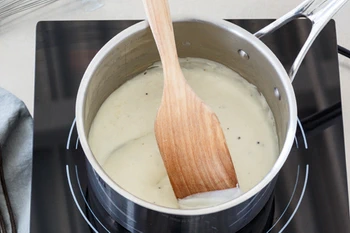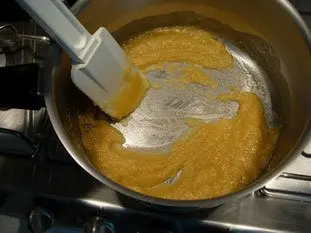This site uses only a few technical cookies necessary for its operation. By continuing to browse, you accept their use.
To find out more...
To find out more...
The (small) miracle of béchamel sauce

Making a béchamel sauce is going to confront you with a little miracle that happens every time: You pour milk over a roux, it's very liquid, you stir over a low heat, and then all of a sudden, miracle, the sauce sets, it thickens, you've got your béchamel.
Let's see what happened.
Let's see what happened.
8,614 4/5 (4 reviews)
Keywords for this post:SauceMethodPrincipleExplanationStarchTemperatureRouxConsistencyBéchamelLast modified on: August 27th 2024
The (small) miracle of béchamel sauce
A basic sauce

Making it is quite simple: first a "roux" mixture of flour and butter, which is heated and colored (hence its name).

Once the roux has reached the right color, cold milk is added, the mixture is very liquid, and you continue to cook and stir over low heat until it thickens (you'll find the full recipe here).
But why does it thicken? As you'd expect, there's no magic involved, just a little physics and chemistry.
Flour and starch
The secret lies in the roux's flour, which contains grains of starch, a complex sugar made up of glucose molecules rolled up into tiny little balls.
It's around 70°C that the magic happens: the grains of starch in the flour break up into smaller grains, starch molecules that begin to absorb the milk around them, up to 20 times their volume, thus increasing the sauce's viscosity.
This process, known as starch gelatinization, takes place between 70°C and 85°C, giving béchamel its characteristic thick, creamy consistency.
Note in passing that this process of starch gelatinization is also at work in, among other things, crème pâtissière or flan, where flour is often replaced by maïzena, a corn starch.
In short: Béchamel thickens because it contains flour that is heated, causing its starch grains to burst and absorb the milk around them.
So béchamel is not just a culinary classic, it's also a little chemistry lesson in action.
Lasts posts
Butter vs. grease
We often read in a recipe where a pastry is put into a mould that, just before pouring, the mould should be buttered or greased. But what's the difference between these 2 terms?December 1st 20251,0135
Getting out of the fridge early
Very often when you're cooking, you need to take food or preparations out of the fridge, to use them in the recipe in progress. There's nothing tricky about this: you just take them out of the fridge and use them, usually immediately, in the recipe. But is this really a good method?November 24th 20251,1365
Who's making the croissants?
When you look at a bakery from the outside, you naturally think that in the bakery, the bakers make the bread, and in the laboratory, the pastry chefs make the cakes. It's very often like that, with each of these professions having quite different ways of working, but sometimes there's also one...November 23th 20251,027
Oven height
When we put a dish or cake in the oven, we naturally tend to put it on the middle shelf, and that's what we usually do. But in some cases, this position and height can be a little tricky, so let's find out why.October 8th 20252,7845
The importance of sieving
In recipes that use a fine powder (flour, powdered sugar, etc.), you'll often see the advice to sift before using it. To sift is to pass the powder in question through a sieve (a very fine strainer) before incorporating it into your recipe. It's often advice, but is it really useful?September 3rd 20257,5473
Other pages you may also like
Double cooking of vegetables
When you cook vegetables, it's not easy to capture and preserve the flavours. It is easy to undercook, but you can make up for it, or overcook, and then it is unfortunately a bit cooked (in the sense of "ruined"). But above all, how to get the maximum of the taste of the vegetable in the pan, then...July 12th 201924 K4.1
The return of the "Norman hole"
You maybe know the "trou normand", this old gastronomic custom typically French which consists in taking a (small) glass of calvados, generally between the last course and the dessert? It's something that seems a bit anachronistic nowadays, having a glass of an alcohol of more than 60° in the...December 18th 202115 K4.8
Choosing a chopping board
It's a no-brainer, surely? If you want a chopping board, just find a piece of wood, and Bob's your uncle! You can happily chop away with a knife and not damage the table or worktop. But in reality, it's a bit more complicated than that. You need to be careful what you are buying, in particular the...May 8th 201250 K4.6
Candied fruits: don't get ripped off
Do you like candied fruit? You might like to nibble a handful or add it to a recipe, like a classic fruit cake or delicious Italian specialities like panettone or sicilian epiphany pie.June 21th 201767 K 24.2
A few tips for effective kneading at home
When you have to knead dough for bread or some other recipe, you may well use a food processor or the type of machine known as a stand mixer. The best-known brands are Kenwood and KitchenAid. They are useful tools, but here are a few tips to help you get the best out of them.June 23th 2021284 K 23.8
Post a comment or question
Follow this page
If you are interested in this page, you can "follow" it, by entering your email address here. You will then receive a notification immediately each time the page is modified or a new comment is added. Please note that you will need to confirm this following.
Note: We'll never share your e-mail address with anyone else.
Alternatively: you can subscribe to the mailing list of cooling-ez.com , you will receive a e-mail for each new recipe published on the site.









